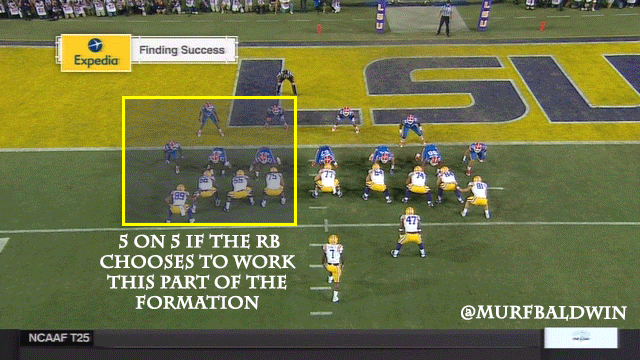
Film study: LSU goes to Single Wing in goal-line TD run
What’s not to like about LSU’s rushing attack?
I used to think Arkansas had the most complete run game due to the combination of personnel (offensive line and running backs), scheme and execution.
But former offensive coordinator Jim Chaney bolted for Pittsburgh and he took the unique creativity with him. I was thought Georgia had the most productive rushing attack, at least among those categorized as pro-style or traditional, but its line hasn’t produced the Herculean efforts seen in years past, at least on a weekly basis, and it doesn’t help that all-world running back Nick Chubb was lost for the season with a gruesome knee injury.
But I have a feeling that if all things were equal, LSU would still have the most complete rushing package as it just seems to be able to string together concepts like you wouldn’t believe.
Personnel-wise, I’ve all but swooned over the talents of left tackle Jerald Hawkins, center Ethan Pocic and right tackle Vadal Alexander, but the freshman guard combination of Maea Teuhema and Will Clapp keeps me up at night with excitement for the type of physical football LSU trots out. (Wait, this is getting a little weird with the swooning and excitement.)
And when your uber-star running back is conjuring up comparisons to my childhood hero, Bo Jackson, you know you are working with something special. And that’s glossing over the quality depth provided by Darrel Williams, Derrius Guice and Nick Brosette — all of whom would be starters on just about every other SEC team.
With the scheme oscillating between outside- and inside-zone concepts, man- and-gap-blocking jaunts, edge-bending runs from Shotgun, Pistol or traditional you can plainly see how I’ve arrived at that conclusion.
But I’ve become enthralled with how offensive coordinator Cam Cameron has enforced his will against defenses geared to slow down his high-powered attack.
One particular play caught my eye in LSU’s thrilling win over Florida, and it was all a numbers thing.
On this particular goal-line run, which looked about as easy as it gets, the Tigers went to a version of the old Single-Wing offense, which took advantage of an athletic QB — in this case Leonard Fournette — by allowing an extra blocker.
This is essentially grown man football as it puts a hat on a hat. His best bet is the left side of the formation as his presence essentially outflanked the defense as they could block every player on that side of the formation.
Initially the play was designed the press the A-gap, where Fournette would have probably had success against an approaching “Fill Defender,” but his best option was to challenge the outflanked portion of the formation. Being as though one player on the defensive line required a double team, this rendered the situation as two on two.
But none of that mattered once the “Y” sealed the edge and an approaching defender who was following the lead-blocker also was effectively shielded.
From there, it was a walk-in on a well-executed play from the premier rushing outfit in college football. The Tigers are so great at this, they could easily trot it out between the 20s and achieve explosive gains.
It truly is a game of inches.

